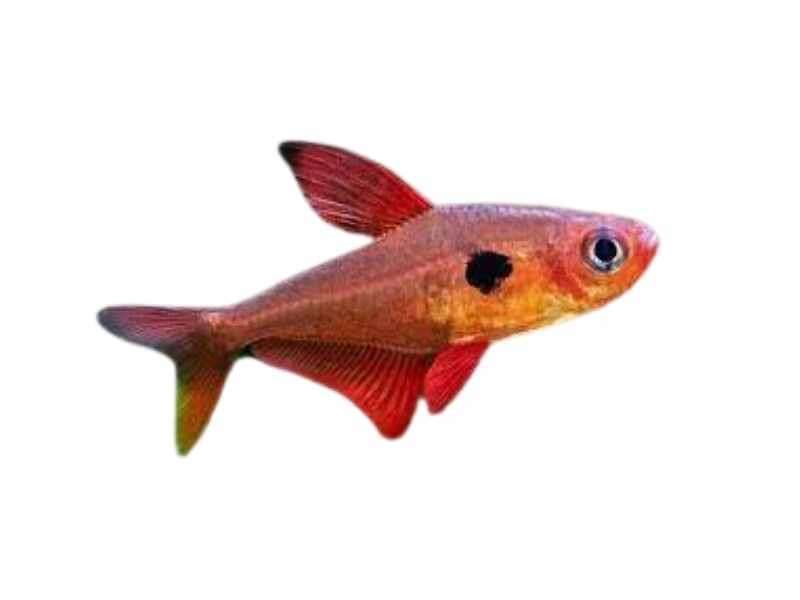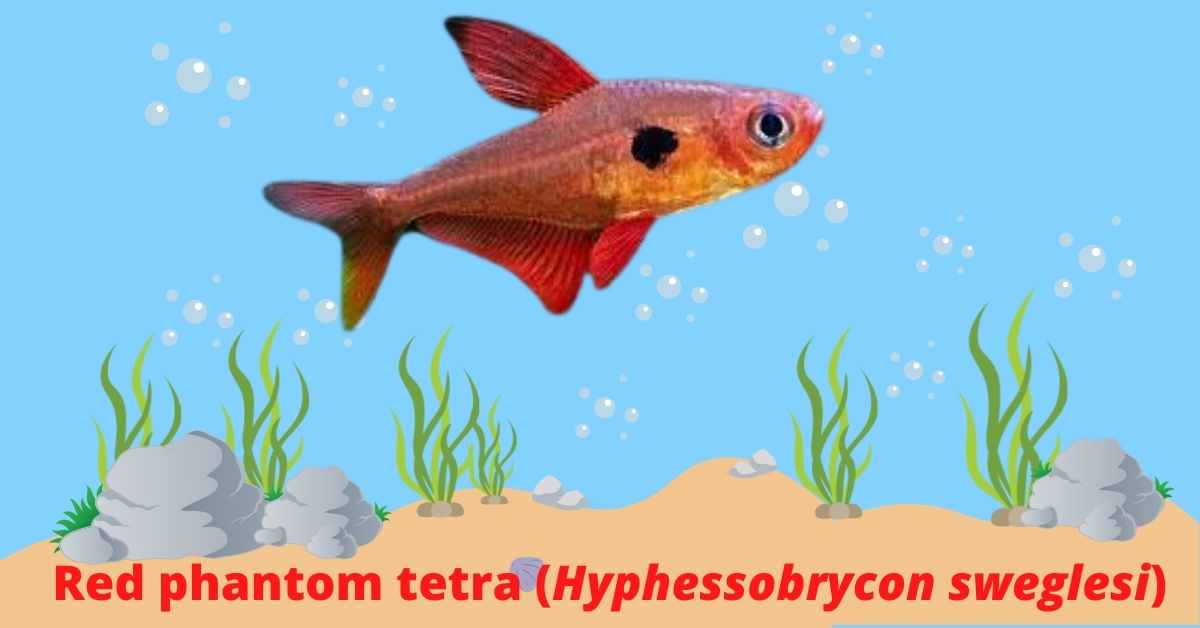The Red phantom tetra-Hyphessobrycon sweglesi is a small, beautiful and brightly colored fish that is popular among aquarium enthusiasts. They are native to the Amazon River basin in South America. These fish are generally considered easy to care for and will do well in most community tanks. The red phantom tetra is a popular aquarium fish due to its attractive coloration and peaceful temperament. They are an active fish that often swims in schools. In the wild, they inhabit slow-moving streams and rivers where they feed on small insects, crustaceans, and plant matter.
Systematic Position
Phylum: Chordata
Subphylum: Vertebrata
Class: Actinopterygii
Order: Characiformes
Family: Characidae
Genus: Hyphessobrycon
Species: Hyphessobrycon sweglesi
Appearance
The red phantom tetra has a deep, metallic red body with black markings and a long tail. They are an active, lively fish that make great additions to community tanks. The Red phantom tetra has an elongated body shape and grows to a maximum length of 2 inches (5 cm) with a lifespan of 3-5 years.

Red Phantom Tetra Quick Facts
Scientific Name: Hyphessobrycon sweglesi
Adult size: 2 inches (5 cm)
Minimum Tank size: 20 gallons
Temperament: Peaceful
Tank level: Middle-top
Diet: Omnivore
Breeding: Egg layers
Water pH: 5.5-7.5
Hardness: Below 10 (dGH)
Temperature: 72°F – 78°F
Care level: Beginner-intermediate
Lifespan: 3-5 years
Feeding
Red Phantom Tetras require a well-balanced diet of both meaty and vegetable foods to maintain healthy. It is not difficult to feed in captivity if you provide them with a varied diet of both live and frozen foods. They are omnivorous animals that will eat both plant material and small invertebrates such as insect larvae but prefer to eat live food. In the wild, these fish typically feed on algae, small insects such as mosquitoes, midges, and mayflies, zooplankton, and detritus found at the bottom of rivers and streams. Some good choices for their diet include bloodworms, brine shrimp, daphnia, mosquito larvae, and tubifex worms. You can also offer them some vegetable matter such as blanched lettuce or spinach leaves.
In the home aquarium, red phantom tetras will eat most types of flake food as well as freeze-dried bloodworms or brine shrimp. When feeding red phantom tetras, it is important to provide a variety of foods to ensure that they receive the nutrients they need for good health.
One of the more interesting aspects of the Red phantom tetra’s feeding behavior is their tendency to school around their food. If you offer a few small feeder goldfish to your tank, you will likely see the Red phantom tetras gather around them and swarm like sharks. They seem to enjoy this activity, and it’s a great way to watch them feed.
Another thing worth noting about these fish is their willingness to eat from the surface of the water. If you have some floating food items like freeze-dried bloodworms or brine shrimp, you’ll see the Red phantom tetras swimming up for a quick bite.
Housing
Red phantom tetras are peaceful fish and do well when it is kept in groups of six or more individuals. They do best in tanks with plenty of plants and other hiding places, as they are shy by nature. In order to keep your Red phantom tetras healthy and happy, it is important to provide them with clean, well-oxygenated water and appropriate tank conditions. In general, these fish are peaceful community members that can be kept with other small tropical fish species.
To keep your Red phantom tetras healthy it is important to perform regular water changes using dechlorinated tap water or RO/DI filtered water. The temperature should be maintained between 72°F – 78°F degrees Fahrenheit and the tank should be heavily planted with driftwood or rocks for hiding places. When it is kept in an aquarium, red phantom tetras require a well-planted tank with subdued lighting and a moderate to low flow rate. They will tolerate pH levels from 5.5 to 7.5 but prefer softer water conditions with a dGH below 10° (178 mg/L).
Tankmates
When selecting tankmates for the Red Phantom Tetra it is best to consider other similarly sized species that occupy different parts of the water column. Red phantom tetras do well when it is kept with other peaceful community fishes such as guppies, mollies, platys, swordtails, corydoras catfish, loaches, as well as some slightly larger community fish like barbs and danios. It is important to avoid keeping red phantom tetras with aggressive or territorial fish, as they may become stressed or injured in such an environment.
Sexing
This species is sexually dimorphic, meaning that the males and females look different from each other. For hobbyists who want to breed red phantom tetras, it is important to know how to identify the sex of each fish so that they can be placed in appropriate pairs. With careful observation it is usually possible to determine whether a particular individual is male or female without too much difficulty.
Male and female red phantom tetras look very similar, making sex differentiation difficult but it appears that some genetic determination occurs. In addition to their different colors, the males tend to be larger than the females and have more pronounced fins. It is also possible to distinguish between the sexes by their behavior; males tend to be more active and aggressive than females.
In general, the male red phantom tetra is distinguished by its bright red color, while the female is duller and has a more grayish hue. However, we can say it in the following ways:
One way to differentiate between male and female red phantom tetras is by looking at their fins. Males typically have longer fins than females do.
Another way to determine the sex of a red phantom tetra is by looking at its behavior around other fish. In general, males tend to be more aggressive than females and will defend their territory more vigorously.
Finally, if all else fails, you can simply wait until the fish spawns and look at the eggs or fry that are produced; males will produce small sperm sacs while females will produce large egg masses.
Breeding
One of the most interesting things about red phantom tetras is their breeding behavior. Red phantom tetra are egg layers and will breed readily in the home aquarium. Red phantom tetras breed during the rainy season, which is typically between October and December.
The male will build a bubble nest out of saliva and air bubbles at the surface of the water while the female watches from below. He then courts the female by swimming around her with his dorsal fin erect. If she is interested, she will follow him to the nest where he will release his sperm over it.
The female will lay her eggs on a surface such as plants or rocks, and the male will then fertilize them. Once the eggs have been laid, the male will guard them until they hatch, which usually takes 24-48 hours.
After hatching, and the fry will become free swimming within another four days. The male will escort them to safety in his nest where he will continue to care for them until they are able to fend for themselves. At this time, you should feed them newly hatched brine shrimp (artemia) or other small live foods. After spawning, parents should be removed from the tank to prevent them from eating their own eggs or fry.
Conclusion
This active, peaceful fish makes an excellent addition to any community aquarium and can be kept with other small fish species without issue. However, when considering tankmates for the Red Phantom Tetra it is important to keep in mind their dietary needs.
These fish are omnivorous and require both meaty and vegetable based foods in order to remain healthy. In a well-balanced aquarium setting they will feed on both live and frozen food items as well as flake food products.

